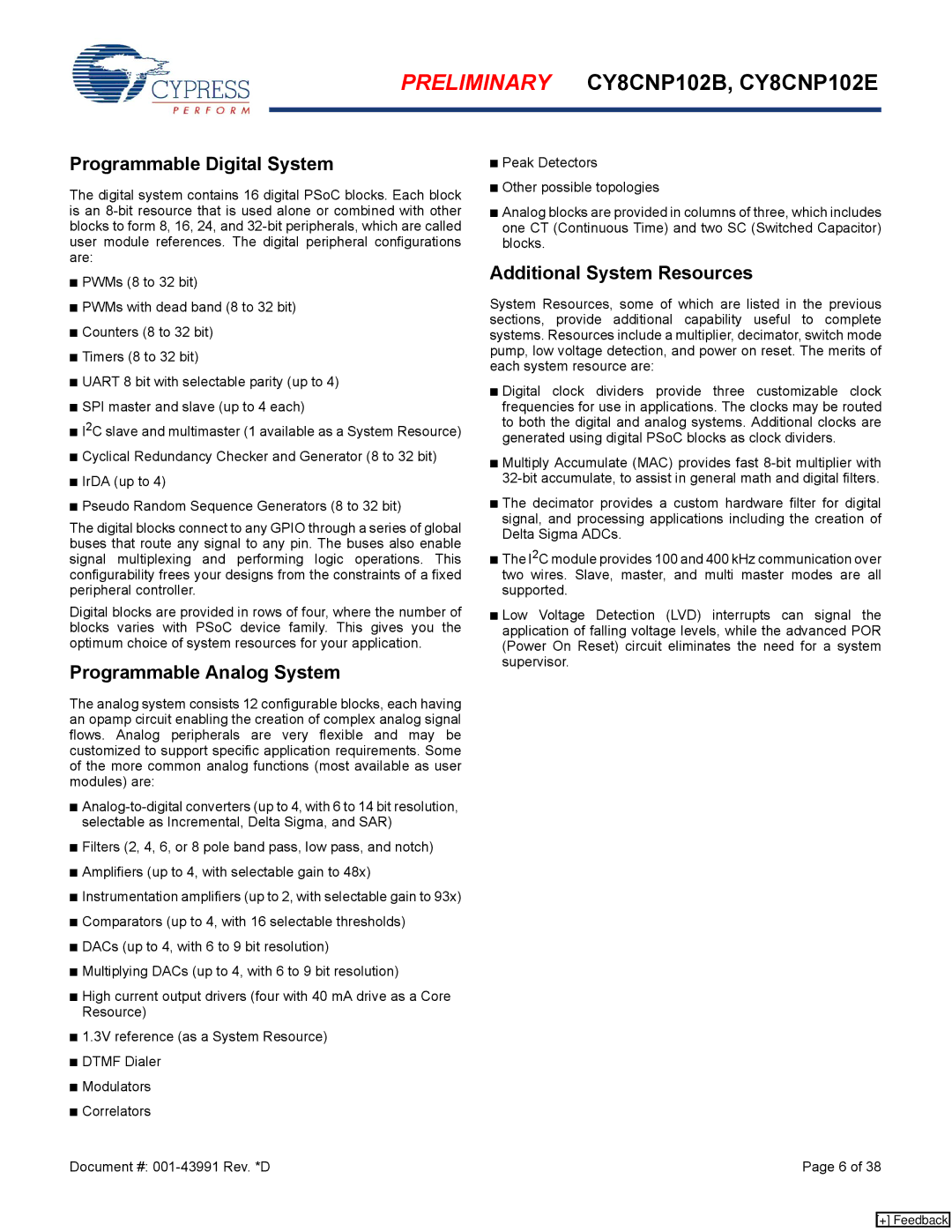
PRELIMINARY CY8CNP102B, CY8CNP102E
Programmable Digital System
The digital system contains 16 digital PSoC blocks. Each block is an
■PWMs (8 to 32 bit)
■PWMs with dead band (8 to 32 bit)
■Counters (8 to 32 bit)
■Timers (8 to 32 bit)
■UART 8 bit with selectable parity (up to 4)
■SPI master and slave (up to 4 each)
■I2C slave and multimaster (1 available as a System Resource)
■Cyclical Redundancy Checker and Generator (8 to 32 bit)
■IrDA (up to 4)
■Pseudo Random Sequence Generators (8 to 32 bit)
The digital blocks connect to any GPIO through a series of global buses that route any signal to any pin. The buses also enable signal multiplexing and performing logic operations. This configurability frees your designs from the constraints of a fixed peripheral controller.
Digital blocks are provided in rows of four, where the number of blocks varies with PSoC device family. This gives you the optimum choice of system resources for your application.
Programmable Analog System
The analog system consists 12 configurable blocks, each having an opamp circuit enabling the creation of complex analog signal flows. Analog peripherals are very flexible and may be customized to support specific application requirements. Some of the more common analog functions (most available as user modules) are:
■
■Filters (2, 4, 6, or 8 pole band pass, low pass, and notch)
■Amplifiers (up to 4, with selectable gain to 48x)
■Instrumentation amplifiers (up to 2, with selectable gain to 93x)
■Comparators (up to 4, with 16 selectable thresholds)
■DACs (up to 4, with 6 to 9 bit resolution)
■Multiplying DACs (up to 4, with 6 to 9 bit resolution)
■High current output drivers (four with 40 mA drive as a Core Resource)
■1.3V reference (as a System Resource)
■DTMF Dialer
■Modulators
■Correlators
■Peak Detectors
■Other possible topologies
■Analog blocks are provided in columns of three, which includes one CT (Continuous Time) and two SC (Switched Capacitor) blocks.
Additional System Resources
System Resources, some of which are listed in the previous sections, provide additional capability useful to complete systems. Resources include a multiplier, decimator, switch mode pump, low voltage detection, and power on reset. The merits of each system resource are:
■Digital clock dividers provide three customizable clock frequencies for use in applications. The clocks may be routed to both the digital and analog systems. Additional clocks are generated using digital PSoC blocks as clock dividers.
■Multiply Accumulate (MAC) provides fast
■The decimator provides a custom hardware filter for digital signal, and processing applications including the creation of Delta Sigma ADCs.
■The I2C module provides 100 and 400 kHz communication over two wires. Slave, master, and multi master modes are all supported.
■Low Voltage Detection (LVD) interrupts can signal the application of falling voltage levels, while the advanced POR (Power On Reset) circuit eliminates the need for a system supervisor.
Document #: | Page 6 of 38 |
[+] Feedback
